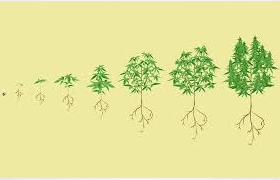As cannabis is becoming legal in many places, it is gaining social acceptance. Medicinal marijuana is now legal in 33 states, which allows patients to access the plant upon a physician’s recommendation. However, quality weed is costly. Some states allow medicinal users to cultivate their own cannabis seeds, which is much cheaper than buying it from a licensed dispensary.
In other places, like Washington and Oregon, recreational marijuana consumption is legal. Maine, Massachusetts, Colorado, and Alaska also allow any person of legal age to cultivate cannabis at home, but there is a limit on the number of plants a person can have.
If you are planning to grow cannabis, we suggest checking your state’s laws and doing some research on the cultivation process before getting started. In this guide, we will look at the life cycle of cannabis and the processes behind a successful harvest.
Why Is it So Important to Learn About the Life Cycle of Cannabis?
When cultivating cannabis, it is crucial to learn about the stages the plants go through during their life. Cannabis is considered an annual, meaning that it goes through a full life cycle (from seed back to seed) within a year or less. In most instances, cannabis concludes its life cycle within four to 10 months.
Basic knowledge forms the foundation upon which growing experience is built. By learning about the life cycle of cannabis plants, you will understand what they are doing and what they need at every stage.
24 Hours to Two Weeks: Germination
All plants, cannabis included, reproduce sexually so the species is carried into another generation. Male and female plants are required for successful reproduction. Hermaphroditic plants exist, but they are rare enough to not be a concern for most growers.
Most growers prefer female plants because they produce a significant number of trichomes, which are small white crystals containing THC, CBD, and other cannabinoids. Male plants are of little use, but they may interfere with the crop if they are allowed to reach maturity. When growing for the purpose of creating cannabis oil or other concentrates, you not only want to choose feminized, but also consider the options listed in our 710 seeds.
Because of this, it is best to look for feminized cannabis seeds. At kindseed.com you will find a wide selection. If you are using regular seeds, there is a 50% chance of getting a male or female plant; however, using feminized seeds guarantees an all-female crop.
All seeds can develop into cannabis plants, but they need care and love to do so. There are several ways to germinate weed seeds, but the paper napkin method is the easiest. Here is how to do it:
Soak several paper towels and lay two on a plate. Spread the seeds evenly on the towel.
Put two more wet towels on another clean plate, then cover the first plate so the seeds are on the inside.
Keep the room’s temperature between 70- and 90-degrees Fahrenheit, checking the plate periodically to keep the towels moist.
Look in on the seeds from time to time, and eventually, taproots will emerge. Germination may take anywhere from a day to a week, so it pays to be patient!
When the taproots come out, transfer the seedlings to the growth medium. Depending on strain selection, your budget, and your cultivation experience, it may make sense to choose a different medium. Some prefer to grow weed hydroponically, but new growers typically choose soil.
Be careful when handling the seeds, as the taproots may break with rough handling. Once the seeds have been transplanted into at least two inches of soil, they are ready to go!
Two to Three Weeks: Seedlings are Sprouting
Once the seeds have germinated and are planted, they will start to grow into the plants we all know and love. Cannabis seedlings will exhibit their trademark characteristics soon after sprouting. During this stage, they produce dual leaves that open out from the stem. Next, their unmistakable leaves will sprout from the top as the plants enter the initial growth cycle.
During the seedling stage, the plants’ root system takes shape. In most cases, cannabis plants stay in this phase for two to three weeks, but the seedling stage may last for six weeks in some cases. Times may vary depending on strain selection and certain environmental factors.
Generally, seedlings should stay at or near 70 degrees Fahrenheit with 60% humidity. Often, cannabis prefers an 18/6 light/darkness cycle once its leaves have emerged. Use a high-nitrogen fertilizer during this stage, but for the best results, be sure to read more about your chosen strain and its requirements.
Six to Eight Weeks: The Flowering Stage
The cannabis plants enter their final growth phase during the flowering stage. This is, by far, the most crucial part of the growth process. Plants can be forced into the flowering stage via reduced light exposure, with a 12/12 light cycle being ideal.
As the plants develop flowers, trichomes develop and the leaves begin to produce a thick, sticky resin. This is an indication of adequate cannabinoid develop, with the product’s potency depending on how long the plants stay in the flowering phase. At this stage, the grow room should be kept at about 68 to 77 degrees Fahrenheit with a 50% humidity level. It is safe to stop feeding nitrogen, but it is best to consider increasing phosphorus and potassium intake.
Cannabis Life Cycles in Indoor and Outdoor Environments
The cannabis plant’s life cycle varies depending on the environment in which it is grown. The most substantial differences lie in the time period between the seedling and harvest stages.
Indoor plants have a short life cycle of approximately three months (slightly less for cloned plants). However, certain strains may take seven to 15 weeks to reach the flowering stage.
One of the biggest benefits of indoor cultivation is that it gives the grower more control over various life stages. For instance, the vegetative phase can be accelerated by planting the plants closer together. Additionally, the flowering stage can be triggered as soon as the plants are the right size.
When the plants begin to flower, they can be put on a 12/12 light cycle for faster flowering. In certain cases, other factors may cause the flowering stage to begin, but the time difference is typically less than five days.
At six to nine months, outdoor plants take longer to reach maturity. This is because the grower cannot control factors such as lighting, which cause the buds to form. In cold climates, seeds should be germinated indoors at least two months before spring. When temperatures rise, it is safe to move the crop outside. Be sure to keep the plants in their containers so they can easily be moved indoors when it is cold or windy.
To eliminate much of the guesswork involved in growing weed, choose autoflowering seeds. No matter the environment in which they are grown, you will have a crop ready in about 10 weeks. We have some of the best autoflowering seeds on the market, so contact us today!
When Is the Best Time to Harvest Cannabis?
Now that the plants have made it through all their growth stages, the fun begins. Before picking the buds, you will have to monitor the crop to decide when it is time to harvest. Timing is crucial here, and it may affect the weight, taste, potency, and aroma of the product.
Experienced growers can tell when it is harvest time by looking at the female plants’ pistils. As they darken and the leaves begin to turn yellow, it is time to pick the buds.
Generally, the experts suggest harvesting the crop when 70-90% of the females’ pistils have turned brown. If they’ve all browned, the buds may be too ripe, and their beneficial effects may be diminished. It is better to harvest early than it is to harvest too late. A timely harvest ensures the potency, taste, and quality of the product.
Pruning Marijuana Plants
After cutting the plants, it is pruning time. Proper pruning ensures well-rounded, enjoyable buds. Plant pruning can be done wet or dry, with the wet method being easier. If the plants are too dry, the leaves begin to curl up and pruning is more difficult. It is a good idea to have a small, delicate pair of scissors just for this task, as well as a healthy measure of patience.
As things can get sticky, it is best to wear gardening gloves during the pruning process. Remove the fan leaves from the buds and then move on to the sugar leaves.
These can be discarded or used in edibles and concentrates. Many growers scrape the resin from their gloves to use in dabs; it is powerful stuff! Once they are pruned the buds can be dehydrated and cured.
The curing process starts after the buds are dry enough to be safely removed from the plant’s stem. When removing the flowers, leave a bit of stem attached so the buds do not fall apart. Place the flower in an airtight glass container and allow it to remain for at least three weeks. The longer the buds cure, the higher their terpene content. After curing is complete, the product can be trimmed and enjoyed.
Growers devote so much time to training and cultivation that the curing and drying processes are frequently overlooked. This is a mistake, however, as these are some of the most important parts of growing cannabis. With patience, the right temperature, and controlled humidity, it is possible to grow high-quality weed every growing season.
Getting Ready for the Next Growing Season
Once the growth cycle has ended, you will have a potent, great-smelling stash of bud. What comes afterward? We have already discussed removing the male plants from the crop to prevent cross-pollination and seed production.
There is a downside to culling; it does not leave any seeds for next season. However, with products from weed-seeds.ca, you will be able to buy and try multiple strains. Some growers would rather clone plants, and the process is simple.
Just cut a four-inch branch from one of the most successful plants in the crop and put it in a rooting solution. The resulting plants will be genetically identical to the parent plant, making for a predictable and easy growing process. It also means that you will get consistent, repeatable results.
Parting Thoughts on Growing Cannabis Successfully at Every Life Stage
It is quite rewarding to grow and use your own cannabis. Not only will you save money compared to the products sold in dispensaries, but you will also have more control over the product’s content. A healthy cannabis crop is the gift that keeps on giving!
If you are an enthusiast who also loves gardening, we suggest giving cultivation a try for at least one season. Before starting, though, it is advisable to learn about your state’s laws. Growing cannabis in an area where it is illegal like South Carolina carries hefty penalties, and may not be worth the risk.
Cultivating cannabis in Texas or Minnesota is not just a way to grow your own medicinal or recreational products; it can be a way of life. Once you have gained some experience, consider expanding your current production caps by ordering our seeds in wholesale. With a little experimentation, some legal knowledge, and high-quality seeds from kindseed.com, it is possible to get into a great hobby, or even make it a career.
Kind Seed Co is a cannabis seed store that sells over 1000 strains to home growers and collectors alike. The company has been in business for 29 years and has a marketing office in California but ships from New York. With a passion for cannabis cultivation, we strive to offer a diverse selection of premium seeds sourced from renowned breeders worldwide. Our mission is to empower growers of all levels with the tools they need to cultivate exceptional plants and unlock the full potential of their harvests.
















